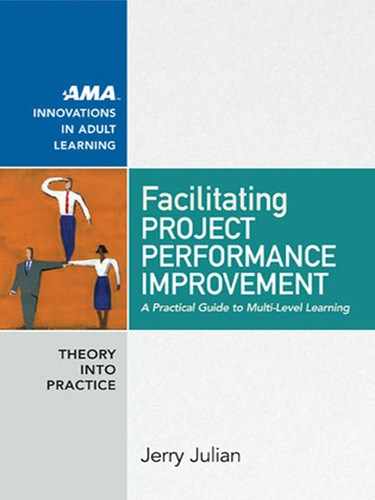Index 203
American Management Association
www.amanet.org
decision making processes and, see deci-
sion making
diagnosis- intervention cycle and, 68–69
dual concerns model and, 63–64
familiarity with project environment,
50–51
goals of group and, 54–55
ground rules for groups and, 69–72,
73, 133
interpersonal relationships and, 55, 56,
111
Kerth’s Prime Directive and, 71–72,
133, 146
Ladder of Inference (Argyris) and,
57–60, 67, 135, 147, 166
models for e ective group process, 53–54
neutrality of, 24–25, 34, 39, 46–48,
100–101, 121
objectivity of, 24–25, 34, 39, 46–48,
100–101, 121
organizational change and, 49–50,
70–71
overview of role, 45–47
problem solving processes and, 60–61,
135
procedures of group and, 55–67
at process level, 46–47
at project level, 46–47, 50–51
RACI model and, 61–62, 152, 157, 158
re ective process and, 48–49
roles of group and, 55
skills required, 48–51
in strategic portfolio alignment, 5,
150–168
at strategy level, 45–46
TALK model and, 60, 67, 135, 147, 166
see also multi- level learning
multiplier e ect
in cross- project improvement, 138
in multi- level learning, 5
mutual engagement, in communities of
practice, 183, 184–185
Nahapiet, J., 111
needs
in con ict resolution, 62
in dual concerns model, 63–64
Nelson, R. R., 117
Newell, Sue, 21, 22, 114–116, 171–177, 182
Nilsson- Witell, L., 22, 116, 173, 175–177
Nonaka, Inujir O., 32
objectives
in continuous project improvement, 133
in strategic portfolio alignment, 154
O’Neil, Judy, 49, 60
opening behaviors, in con ict resolution,
65
operational objectives, in strategic portfo-
lio alignment, 154
organizational learning, see multi- level
learning
organizational learning movement, 29
organizational priorities
changes in, 15, 106
investment, 154–156
Oshri, Ilan, 171, 172
outcomes, of productive re ection, 29
Pan, S. L., 171, 172
Parry, Charles, 2, 30
participation, in communities of practice,
182
Pentland, Brian T., 116, 117
Pepsi, 77
performance feedback
in continuous project improvement,
130–131
in strategic portfolio alignment,
162–163
pilot improvements, in cross- project
improvement, 144–145
Plovnick, M., 54
PMO, see project management o ce
(PMO)
Polanyi, Michael, 28
Poppendieck, Mary, 35
Poppendieck, Tom, 35
portfolio of projects, see strategic portfolio
alignment
postmortems, see postproject reviews;
structured retrospectives
204 Index
American Management Association
www.amanet.org
postproject reviews
as boundary practice, 84–85
in continuous project improvement,
134–135, 136–137
continuous systems- level learning ver-
sus, 24–25
defensive routines and, 19–21, 39
disadvantages of, 16, 23–24, 171–177
documentation and storage in data-
bases, 3–5, 22, 24, 89, 109
impact of re ection deferred to end of
project, 74–75, 107–108, 120
importance of, 16–17, 121
lack of access to, 109
popularity of, 21–22
process versus product knowledge in,
174–176
red- light learning and, 17–21
social practices in, 172–174
structured approach to, see structured
retrospectives
time pressures in, 19, 20
top- down approach to, 20–21, 23–24
traditional uses of, 3–5, 16–17, 21–24
power
lack of direct authority, 103–104, 110
learning and, 48
learning as struggle for, 110–111
premise re ection, 28, 39–40
Prencipe, Andrea, 19, 21, 22, 173, 176, 177
principles of multi- level learning, 35–40
customer satisfaction, 35–36
re ection at multiple levels, 39–40
short cycle times, 37
systems perspective, 38–39
team learning, 17–18
third- party coaches, 39
waste elimination, 36
welcoming new insights, 36–37
problem solving, 60–61
in continuous project improvement, 135
procedures
boundary management, see boundary
management
communication, see communication
process
con ict resolution, see con ict resolution
decision making, see decision making
multi- level learning coach and, see
multi- level learning coach
problem solving, see problem solving
process improvement
as boundary encounter, 92–93
in multi- level learning, 5, 46
process knowledge
communicating, 148
in conceptual framework for PMO
leader role, 115–116
de ned, 116
dilemma of, 175–176
product knowledge versus, 115, 116,
174–176
project organization and, 175–176
process re ection, 28, 39–40, 46, 94, 151
Procter & Gamble, 77
product development group, see project
management o ce (PMO)
productive communication, 60
productive re ection, 28–30
in After Action Review (AAR; U.S.
Army), 27, 30–31, 34, 40
awareness of importance of, 119
key features of, 29–30
nature of, 28–29
need for, 28, 119
questions in, 49, 121
role of multi- level learning coach and,
48–49
throughout the project, 102–103
product knowledge
in conceptual framework for PMO
leader role, 115–116
de ned, 115
process knowledge versus, 115, 116,
174–176
professional artistry (Schön), 27–28
professional development
as enabler of cross- project improve-
ment, 101–102
formal training in project management,
81, 94–95
project charters, 71, 142, 143
..................Content has been hidden....................
You can't read the all page of ebook, please click here login for view all page.
